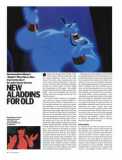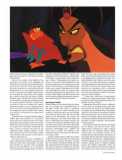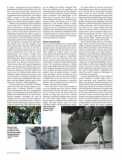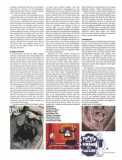



Along with several other movies of the last few years, Disney's latest film, Aladdin, marks animations return to the mainstream. Once upon a time, everyone who went to the movies watched animation. In the earliest days of cinema, before the phrase ‘animated cartoon was coined, shorts in which wiggly lines formed faces as if by magic — for example Stuart J Blacktons Humorous Phases of Funny Faces (1906) - were shown alongside the live-action Western scenes and one-gag comedy skits that built the cinema.
[…]
The Genie is the main locus of Aladdin's injokes, continually disrupting the quasi-oriental medieval world with anachronisms. His presence provides the spectator with an ongoing game of spot-the-reference as he transforms into Arnold Schwarzenegger, Robert De Niro in Taxi Driver, Pinocchio, William F. Buckley, Cab Calloway, the Devil from Fantasia, Arsenio Hall, Ed Sullivan, Groucho Marx, Jack Nicholson, and a Macy's Thanksgiving Day Parade announcer, to name but a few. Meanwhile, there are guest appearances from Sebastian the crab from The Little Mermaid, a pink elephant from Dumbo, and a plug for Disneyland at the films end. Dedicated film buffs can impress their friends by pointing out the appearances of the directors, John Musker and Ron Clements, and studio executive Jeffrey Katzenberg as extras in the crowd during the ‘Prince Ali number.
Nancy Reagans Gulf War
While children will no doubt enjoy the clowning, a lot of them won't understand many of the jokes. Aladdin thus marks a significant break in the way the studio conceives of its audience. Uncle Walt used to say that his films were made not just for kids, but for the child within us all. Katzenberg, who oversaw the film's production, has been frank about his aims to differentiate the studios product and to target new audience segments rather than win souls. And much as he reveres the Disney animated classics of the past, Katzenberg pragmatically acknowledges that, "stylistic leftturns such as Aladdin are essential if the animation division, with well over 700 artists, is to remain vital".
[…]
The Aladdin controversy centres on its depiction of Islamic and oriental culture. Some might think it ludicrous to expect cultural accuracy from an animated cartoon; others contend that it is precisely because of its medium that the film should be questioned. As the Disney Studio discovered during the Second World War, animation is a highly effective tool for propaganda, its cosy, innocuous image having a special power to palliate unpleasantries and validate stereotypes. There are some cartoons from the 30s and 40s which are now almost never shown because of their racism - Bugs Bunny Nips the Nips (1944), or Coal Black and De Sebben Dwarfs (1943). In fact, the first, and so far as I know only, animated short to be censored by the Hays Office at the time of its production was Warner Bros Clean Pastures (1937), a parody of The Green Pastures (1936) which was seen as potentially offensive in its depiction of black Southern Baptist religion.
Whether or not Aladdin is racist is something viewers will have to decide for themselves. Some may feel that it caricatures Arabian people as violent and slavishly obedient to barbaric laws, as when a street trader threatens to cut off Jasmines hand when she offers an apple to a street urchin without paying for it. But which is the distortion, the traders unjust retribution or Jasmines generosity? Throughout the film laws are figured as arbitrary and whimsical. The Sultan insists that his daughter must marry a prince by her birthday, only cheerfully to repeal the edict at the end. Is this also a sleight at the Islamic judicial system, or just a way of resolving the story with the casual conclusiveness the musical comedy form demands? And what are we to make of the films villain, Jafar, whose anorexic shape is said to be modelled in part on Nancy Reagan and who quotes two phrases of George Bush "there's a new order now", when he temporarily takes over the lamp and political power, and later "read my lips"? Given that the film was in production during the Gulf War, is Jafar to be read as part of a hidden liberal subtext that implicitly criticises America's use of power, or is he just another stereotypical example of the myth of the devious, manipulative Arab statesman, who like Saddam Hussain steals a kingdom, and is called the "Thief of Baghdad"?
Even the visual style of the film is a hybridisation of oriental and western imagery, to the point where it becomes difficult to divine where incorporation ends and appropriation begins. The studio-sponsored book Aladdin: The Making of an Animated Film asserts that the production designers "developed the style of Aladdin from the study of Persian miniature paintings from approximately 100 to 1500 AD; various Victorian paintings of eastern cultures, numerous photo-essay and coffee-table books on the Middle East; Disney animated films from the mid-Forties to the mid-Fifties, and Alexander Kordas 1940 film, The Thief of Bagdad". It also describes how Rasoul Azadani, the films layout supervisor, used photographs of his home town in Iran for locale design. Just as other elements of the film are caught in a play between realism and fantasy, so is its "look" imbued by a play between fidelity to Arabic design and the adaptation of western-derived imagery of the east. If animators are now more sensitive to how they depict ethnic groups, perhaps those who worked on Aladdin felt entitled to slacken the reins of caution when it came to a story so deeply assimilated into western folklore and performance tradition.
[…]